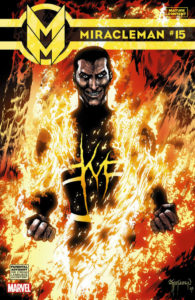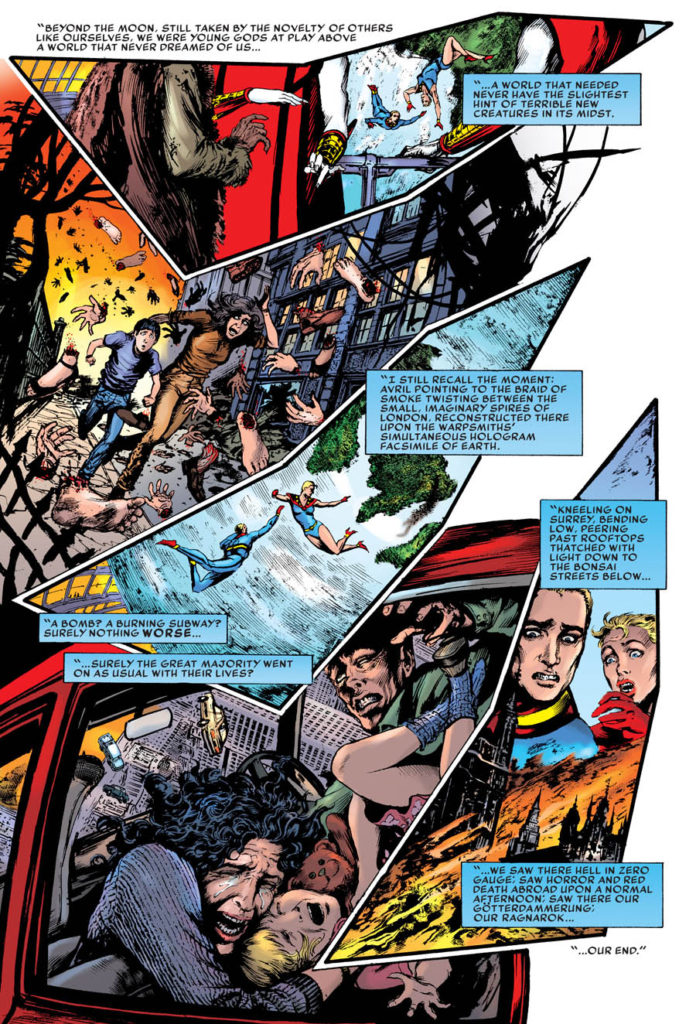 Written by Alan Moore
Written by Alan Moore
Art by John Totleben
48 pages, color
Published by Marvel Comics
When Miracleman #15 was first published in November 1988, saying it was attention-grabbing is a bit of an understatement. Those who were reading the title found themselves confronted with a comic where Alan Moore and John Totleben took the normal levels of violence present in comics and upped the ante considerably, presenting a series of images unlike anything else published at the time. Since that time, so much of what occurs in Miracleman #15 has been reused and recycled in both comics and other media forms. But with the shock value stripped away, it’s almost a relief to see that Miracleman #15 still holds up to a critical eye; it’s still an excellent if disturbing comic.
Miracleman #15 is the climax to the third volume of Miracleman, with one final issue displaying the aftermath still to come. Moore and Totleben don’t skimp at all on the promise of a fight to end all fights; the battle between Miracleman and Kid Miracleman is more than brutal, it’s apocalyptic for the city of London. That’s something that fits in perfectly with the overarching story of volume 3, suitably titled, “Olympus.” This is the rise of Miracleman and his associates to godhood, and the battle here is nothing short of a god versus the devil himself.
Moore asks the reader what a truly insane and evil person with near unlimited powers could do to the world, and has Totleben deliver the results in eye-searing detail. This isn’t a man who is going to build a crazy device, or perhaps hold people captive. This is carnage, pure and simple; never mind the ruined buildings, but the moments where you see the tattered skins of his victims flapping in the breeze is when you realize that Miracleman isn’t fighting a bad guy, but rather a madman in every sense of the word. The fact that Kid Miracleman is able to accomplish (or rather, destroy) so much in such a short period of time speaks well to what Moore and Totleben are trying to present here: he is a threat not just to Miracleman and allies, but literally the entire planet.
 Along those lines, the battle between the forces of good (Miracleman, Miraclewoman, Huey Moon, and Warpsmiths Aza Chorn and Phon Mooda) and evil is suitably difficult. The attempts to stop Kid Miracleman start in a standard manner, but quickly shift to increasingly inventive and desperate. The ways in which first Aza Chorn and then Miracleman ultimately defeat Kid Miracleman are both memorable, but in different ways. Being inspired by Japanese culture, Aza Chorn’s usage of his Warpsmith abilities to bring Kid Miracleman to his knees feels almost like a Japanese koan. It’s a smart but elegant solution on how to stop an invulnerable foe, and it’s an example of a writer using a logical method to resolve a plot rather than a random, previously unseen power.
Along those lines, the battle between the forces of good (Miracleman, Miraclewoman, Huey Moon, and Warpsmiths Aza Chorn and Phon Mooda) and evil is suitably difficult. The attempts to stop Kid Miracleman start in a standard manner, but quickly shift to increasingly inventive and desperate. The ways in which first Aza Chorn and then Miracleman ultimately defeat Kid Miracleman are both memorable, but in different ways. Being inspired by Japanese culture, Aza Chorn’s usage of his Warpsmith abilities to bring Kid Miracleman to his knees feels almost like a Japanese koan. It’s a smart but elegant solution on how to stop an invulnerable foe, and it’s an example of a writer using a logical method to resolve a plot rather than a random, previously unseen power.
And then there’s the final confrontation, something that’s been reused in a series of homages and outright lifts over the years. As a result, readers will probably see it coming far more than those who first picked up the comic in 1988 did. But here’s the thing: strip away the shock and surprise and it’s still remarkably effective. The emotional undercurrent of the scene between the two characters is the big moment, not the surprise of how it’s accomplished. Moore gives both characters so much grief, regret, and sadness that all these years later I found myself still affected by that final scene.
Totleben’s art recolored by the legendary Steve Oliff is so amazing that it’s all the more heartbreaking that we get so little art from this raw talent these days. Totleben’s thin, graceful lines are so beautiful that it makes the hideousness of Kid Miracleman’s rampage that much more memorable. The aftermath is haunting, a level of carnage that it would be hard for anyone to not be permanently changed by. For a moment that literally changes the world (as you’ll see in next month’s aftermath), Totleben and Oliff deliver over and over again. There’s not a single artistic misstep here; Totleben handles every emotion from rage to sorrow, and Oliff’s recoloring of the pages is so deftly handled that it makes you feel like he had been the original color artist right from the start.
Even the page layouts of Miracleman #15 are the sort of craft that now is a bit more common but at the times was a step ahead of most artists. Look at the panels on page 2, drawn as jagged shards tumbling down like the wreckage that Kid Miracleman has created. It’s almost hard to notice them at first because you’re so busy seeing the horror that they encapsulate. But every page is like that, thought through carefully to provide the strongest impact on the reader, and one that rewards multiple re-reads.
Miracleman #15 was for many ears a legendary comic, one that commanded incredibly high prices in the back-issue market. It’s easy to claim that happened because people wanted to see the gore and destruction. I think the reality is something far more important: it’s the climax to all of Moore’s revamp of the comic, a confrontation building since the very first installments in Warrior magazine. Does it deliver what it promised? Most certainly. All of these years later, Miracleman #15 succeeds because of the intelligence, the emotion, and the amazing craft on display here. The series coming back into print, finally, was most definitely worth it so that new readers can see it all for themselves.

RT @gregmce: REVIEW: Miracleman #15: http://t.co/liaEr0nZNB
RT @gregmce: REVIEW: Miracleman #15: http://t.co/liaEr0nZNB